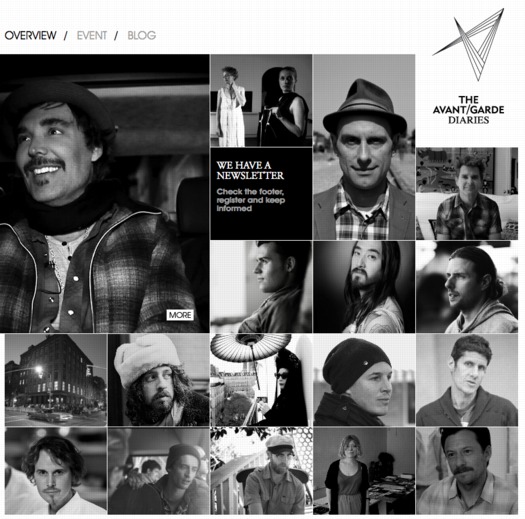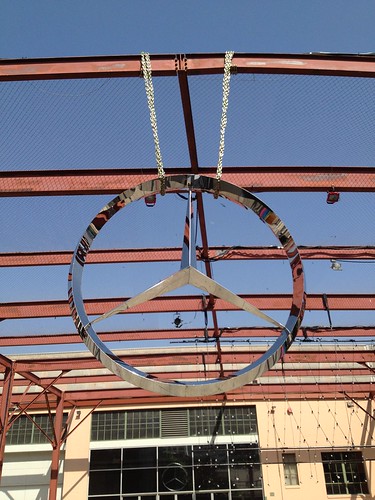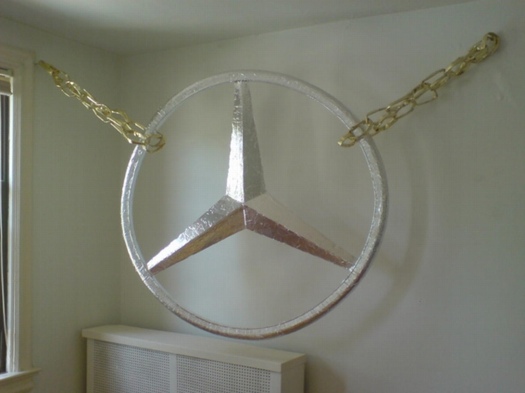
image via 0823n’s flickr
I swear, I’ve tried to keep it all on Twitter, but in the wake of Schimmelgate, I can’t help feeling that the debate over Jeffrey Deitch’s increasingly depressing tenure at MOCA overlooks one of the most damning incidents: Transmission LA: AV Club, the Mercedes-Benz exhibition curated by Mike D that suddenly displaced and delayed the opening of Philipp Kaiser and Miwon Kwon’s Land Art show, Ends Of The Earth.
Maybe it’s been underexamined, misunderstood, or just quickly condemned as a “marketing spectacle.” But I think Transmission LA is actually a show, an unusually pure embodiment of the programming vision Deitch and his patron Eli Broad hold for MOCA, and for art itself. But that means Transmission LA also expands–and complicates–the comfortable moral outrage against Deitch and MOCA; because the forces and assumptions that gave rise to it–art as leisure, entertainment, consumption experience, luxury good and corporate branding project–are already operating across vast swaths of the contemporary art and museum world.
MOCA’s own PR weirdness about its [non-]announcement and the ostensible obviousness of the show’s marketing objectives contribute to an inaccurate perception that Transmission LA was an impulsive, hastily organized, poorly handled, maybe slightly desperate corporate rental deal: that Mercedes and its ongoing lifestyle branding initiative, The Avant/Garde Diaries, swooped in unexpectedly to save the big, hard-to-fund scholarly show set to open in a few weeks by offering a six-figure proposal for a pop-up show “curated” by their aging rapper, if only the cash-strapped museum had a space available for a few weeks.
In fact, as the LA Times’ Mike Boehm reported a couple of weeks after the Mercedes show appeared on MOCA’s calendar, such a mix of “celebrity, fashion and youth culture” were “a key reason [Deitch] was hired in 2010.” Boehm wrote,
Deitch said he helped plan the festival for its sponsor, Mercedes-Benz, including recruiting Mike D as the curator who will oversee its offerings of art, music and food. Admission is free. With Mercedes covering the cost and making a contribution to the museum, Deitch expects it to generate several hundred thousand dollars for MOCA’s more conventional activities, while continuing his populist push.
“We need to build the museum as a social space,” Deitch said in an interview Tuesday at MOCA.

image via Breaking Through – In Preparation for TRANSMISSION LA – AV CLUB
Deitch met Mike D [whose given name is Mike Diamond] in 2010, while participating in a documentary about Jean-Michel Basquiat by the musician’s filmmaker wife Tamra Davis. The Daily Beast, writing about the April opening, said “According to Diamond, Deitch called him a year ago to propose that he curate Transmission: LA and has been very hands-on since.” So Deitch was working on Mercedes’ show at MOCA in April 2011, and no one [sic] knew about it until six weeks before it opened.
But that is not Deitch’s only involvement in Mercedes’ branding activities. In December 2011, two months before Transmission LA was announced on Mercedes’ site, and 3.5 months before MOCA’s involvement was revealed publicly, Deitch made a an Avant/Garde Diaries video at Art Basel Miami Beach, along with Theaster Gates.
Ironically, considering the criticisms leveled against him now, Deitch’s role in the video is to provide gravitas and historical context. Specifically, it was to anoint The Avant/Garde as the rightful heirs to the “the avant-garde,” aka the world Deitch had come up in, the “small community” that was “the art world” in “the early 70s.” In other words, exactly the kind of intergenerational baton-passing that 90’s veteran, Deitch collaborator, and Avant/Garde-ist Aaron Rose called for in his recent defense of Deitch’s MOCA mission. [It’s not really relevant, but the video includes Deitch fluff-flubbing Gates’ affiliation with the Art Institute, instead of the University of Chicago.]
In his curator’s statement in the “official Audio-Visual Club zine“ [pdf], explaining how the whole thing came together, Mike D reflects some of Deitch’s curatorial light:
When Jeffrey Deitch first approached me about doing this show, the assignment was more simple. It was to pick 10 or 11 artists that I found inspiring, or was inspired by. I quickly, however, spiraled out of control.
I decided to be a bit more ambitious and go for a complete sensory experience inclusive of food, coffee, books, film, and many multi-media installations.
…
…I realized the theme had emerged: this notion of how visual art is informed by and inspired by music, and how that then turns back to music. after that, I knew that we also had to have a musical component to the exhibition with DJ nights, performances, etc. to complete the circle.
the food and coffee elements were conceptualized with Jeffrey originally because I thought of the project as two-fold. One is that LA is all about car culture. the tricky thing is to get people out of their homes, so you need to check multiple boxes off in one day and destination. the other is that we’re trying to create this all- encompassing sensory-rich environment.
“Pick 10 or 11” “inspiring” artists, add coffee and a DJ, crank “everything up to 11,” and you have “the new MOCA,” as Mike D put it on a MOCA blog, “a 21st Century institution that redefines how contemporary art is presented in a cultural context.” Which is modulated a bit from the way he described the show in April, before the Schimmel hit the fan: a “grown-up theme park, a Six Flags for adults.”
In The Avant/Garde’s preview for the show, “TRANSMISSION LA: AV CLUB Concept by Mercedes Benz [! -ed.] Curated by Mike D”, Diamond’s fragmented, aphoristic narration has been edited together to sound like nothing so much as International Art English, spoken with a recovering rocker patois:
Installations cranking everything up to 11…musicians…visual artists…trying to break it up…so that’s not a typical white wall, concrete floor kind of gallery experience.
An experienced curator would have said, ‘There’s no way this is going to be possible.’ But I didn’t know! [muffled laugh of whoever he’s talking to] So I just kind of like…’Do it!'”
Experiential, mind-altering fun? Like, my dream of what my house might be like. Like a fantasy of what it would be if you came over. Why don’t I meet you, we’ll have a cup of coffee, I have the big, old Tom Sachs sound system, and we’ll play some music on that.
The museum is transformed, the literalization of a dreamscape, where your fantasy of hanging out at your favorite musician’s house comes true.

Image via 0823n’s flickr
And right in the middle of the show, waiting to upend your “gallery experience”? The 2013 Mercedes CSC, or Concept Style Coupe. Bet you didn’t expect that!
Deitch’s show, conceived by The Avant/Garde Diaries, which he has been consulting for, and organized by the inexperienced guest curator he picked, and with his intimate involvement, turns out to be more than a crankin’ exploration of “how visual art is informed by and inspired by music”; it’s also one step–sandwiched between “leaked” PR photos and an official unveiling at the Beijing Motor Show–in the highly orchestrated marketing campaign for the launch of the new, mid-sized version of the CLS 4-door coupe.

Which is not to imply that The Avant/Garde Diaries was created by Mercedes just to launch one new mid-market sedan; it’s really a platform for shifting the cultural perception of the Mercedes brand itself. Taken as a whole, The Avant/Garde’s Diarists appear to be rebellious, creative, successful, in their late 30s and early 40s, prone to wearing large plaid, white with a token Asian–and almost exclusively male. It’s an aspirational lifestyle profile from which you can neatly reverse engineer the Mercedes driver profiles the company’s trying to counterbalance: suburban yoga moms, Orange County realtors, Hamptons d-bags, and unsettlingly blingy black folk.

diptych via notcot
It’s also an attempt–and in Transmission LA’s case, a literal one–to make peace with a generation and culture which once considered Mercedes Benz as the contemptuous Other, the target of their scornful, youthful mischief, and to bring them–and their upscale families–into the corporate fold. And so a rapper who once encouraged his fans to turn stolen hood ornaments into necklaces is hired to make official versions for the Brand Communications team and party VIPs. And is provided with giant, authentic Mercedes logos to scatter about the galleries, and to dangle from gold chains on the front of the museum.

image via shapthings’ flickr
[No doubt too late disclosure: I just sold one of our Mercedes; I trust the one that’s left is so boring as to be aspirational to no one.]
And this is all of a piece, not just with Deitch’s strategy for MOCA, “guest curators” and all, but with his conception of art and its role in the culture. Speaking to Mike Boehm in March, Deitch cited the fundraising difficulties faced by academically focused shows like Ends of the Earth:
It’s much easier, he said, to raise money for shows by popular figures, “where collectors are excited about the artists and brands want to be connected to the artists’ image. Fundraising for historical shows with great artists who don’t include today’s art-world stars is a great challenge.”
It’s a sentiment that comes up in The Avant/Garde Diaries’ latest video featuring 90s magazine photographer David LaChapelle and Berlin dealer Reiner Opoku, aptly titled, “Reinventing Yourself”:
[Opuku]: I’d say recently, we see a lot of need for certain brands–or the desire for brands to work with creative people. First of all, you have to find a language between these two: between the creator and the brand. Therefore you need people in between, who, let’s say, orchestra [sic] the whole enterprise, the whole idea.
LaChapelle’s reboot as a fine artist began, as you might guess, with a 2005 sideshow/”retrospective” at Deitch Projects. It’s all enough to make me wonder how deep and ongoing Deitch’s involvement with Mercedes’ marketing is.
More importantly/depressingly, it makes me wonder if there really is anything to be done about it. Transmission LA includes several artists I actually like, respect, or at least take seriously. Even Hans Ulrich Obrist has done a video for the Avant/Garde Diaries [which rather succinctly demolishes Aaron Rose’s defense of MOCA in the name of forgetting the irrelevant past. Count me as Team HUO on this one, obviously.]
Here’s Peter Saville shooting down the fantasy of a contemporary avant-garde in–what else?–his video for The Avant/Garde Diaries, titled awesomely, “Disco Ball of Everything”:
This last decade, we’ve had a broadly pluralist culture. Basically, we have a kind of, entirely multi-track system. The system has evolved to encompass all forms of provocation. We’ve entirely commercialized–and commoditized–life culture. It’s perfectly understood now that you will dress any way you like. You can have dance music with rock music with classical music. All of these genres in a multi-faceted, contemporary kind of reality. Like a kind of disco ball of everything.
If only Saville would curate MOCA’s show.
Meanwhile, museums seemingly not in peril have negotiated far-ranging sponsorships with car companies, from VW’s multi-year deal with MoMA and PS1 to BMWGuggenheim’s globehopping program on urban design. But MOCA’s Mercedes tie-up doesn’t remind me of these more traditional underwriting agreements. The closest analogue I can think of is YouTube’s complicated content/sponsorship/museum rental relationship with the Guggenheim for the YouTube Play Biennial in 2010. [For Mercedes’ part, nothing beats Arne Quinze’s Uchronian campaign at Burning Man for the 2007 Lexus LS460 for inspiration in developing a long-term, stealth co-optation of a non-commercial art context for a car launch.]
Is MOCA really only guilty of indelicate execution? Are the differences between Deitch’s boundary blurring antics and the rest of the art/museum world’s stimulation-seeking, crowd-pleasing, and corporate sponsor-pleasing differences of kind, or merely of degree? These are questions I’ve been grappling with as MOCA’s credibility has been disintegrating in front of me.
On the one [personal] bright side, it makes me feel slightly better, more aware and critical, and slightly less implicated, to have made this giant, blingy sculpture, which is now hanging in my living room:

Untitled (MOCA Mercedes, after Mike D), 2012, ed. 10
Like the Thomas Hirschhorn chain sculptures which were its inspiration, this is made from cardboard, aluminum tape, gold foil, and packing tape. As such, it’s designed to last just long enough to serve its purpose, to be considered, favored, consumed/shown, and flipped a few times at auction. Anything longer than that will be a problem for the conservators, assuming such a position exists in the museum of the 21st century.
This one, I think I’ll keep for my self, but I suppose I’ll make a few more. The price’ll go up after Deitch leaves, with the increase going to MoCA.
